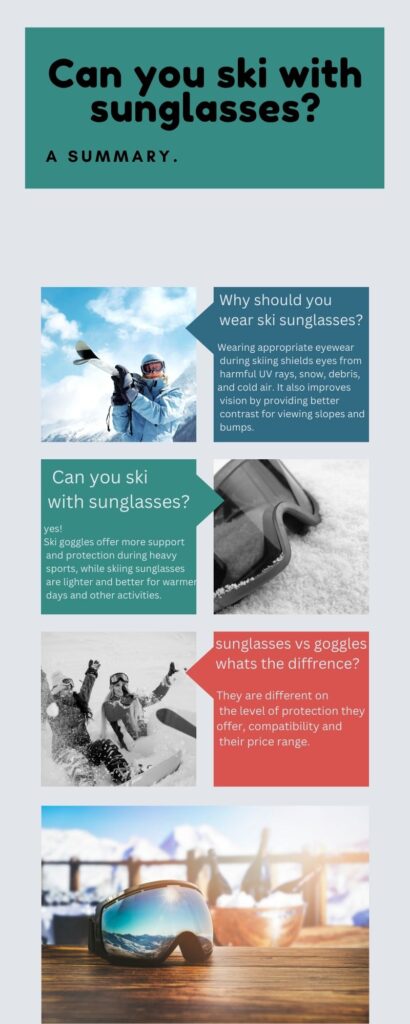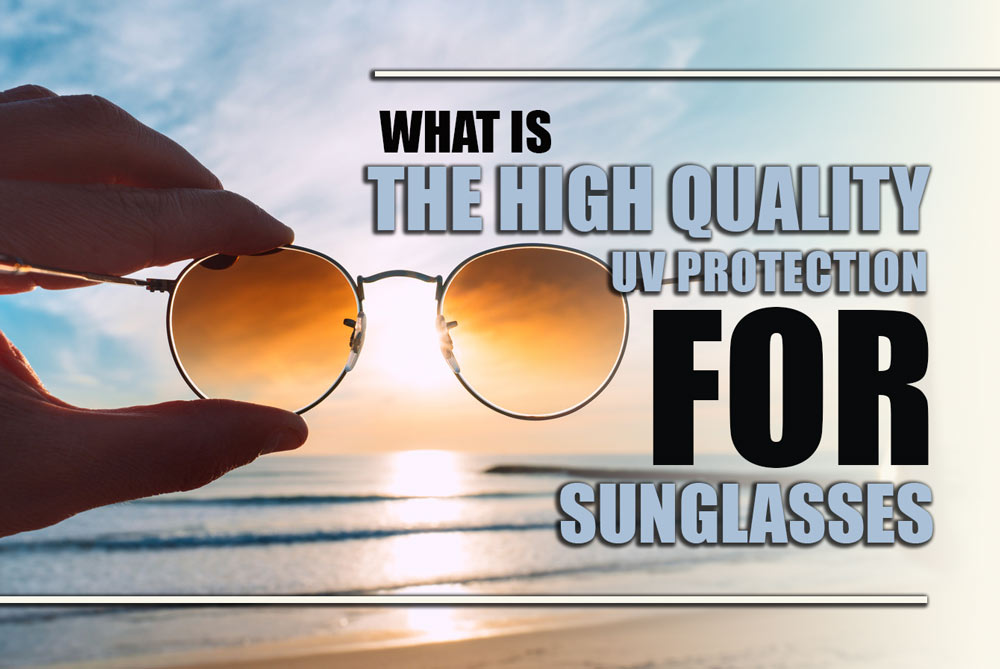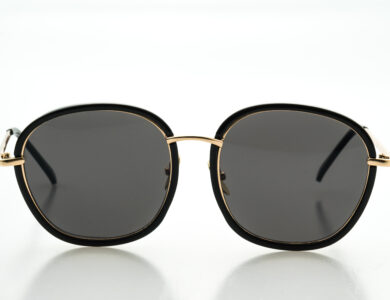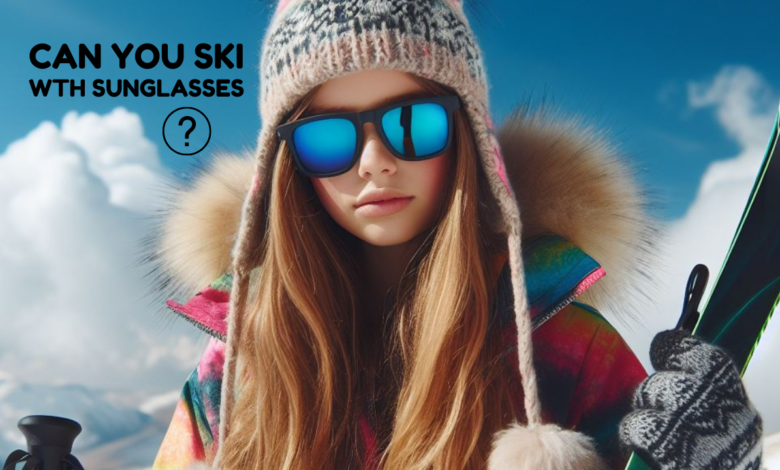
can you ski with sunglasses ? To answer your question we have to say: yes! you definitely can ! In this article, we will help you understand the importance of suitable eyewear when skiing and how to choose the best sunglasses. So, let’s get right to it!
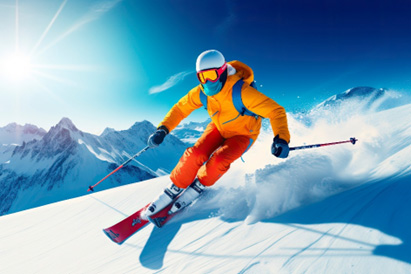
Why should you wear ski goggles or ski sunglasses?
While skiing, the glare of sunlight reflecting on the snow can disturb your vision or, in more severe cases, damage your eyesight permanently. Also, you need something to keep the snow, sleet, and other kinds of debris off from your eyes. You must always ensure your eyes are safe from harmful UV rays. In addition, wearing sunglasses or goggles will give you the ideal contrast to see the slopes and bumps in your way. Do Not forget one of the essential reasons: wearing suitable snow sports eyewear while doing winter sports will keep the cold from your eyes and make the experience far more pleasant.
Can you wear sunglasses when skiing?
The short answer is – yes! -. When preparing for a nice ski trip with your family or an adventurous one with your friends! You have multiple options for your eyewear. You can choose to wear ski goggles or sunglasses. And each of them has a wide variety to choose from. If you’re reading this article, you’re probably uncertain. Ski goggles are the more typical choice and the safer ones. Skiing goggles will provide you with more support and protection than sunglasses. Still, in comparison, skiing sunglasses are lighter and more accessible. It will probably be more fit to wear sunglasses on warmer days when you don’t plan to do heavy sports and you want to do other activities. After all, it is possible to wear sunglasses while skiing, but you should consider all the aspects first.
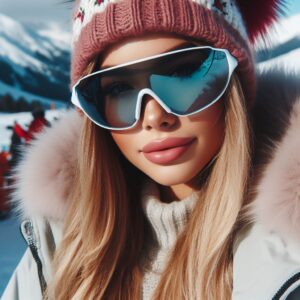
A more precise comparison between ski goggles and ski sunglasses
Protection:
Sunglasses are more stylish and elegant and more accessible to wear. They offer ultraviolet (UV) protection and reduce glare, allowing you to navigate the glistening terrain easily. However, when it comes to skiing, they may fall short in shielding your eyes from the relentless rush of cold air and flying snow, leaving you vulnerable to discomfort and potential injury.
Snow goggles provide more protection with their durable, wraparound design and snug fit. With wide, double lenses incorporated, they enhance visibility, reducing distortion and preventing fogging, ensuring you can conquer any terrain with precision and confidence.
On the slopes, sunglasses may evoke a sense of poise and sophistication. Still, regarding rugged protection, ski goggles stand as stalwart defenders, ensuring your eyes remain safe and focused, allowing you to embrace the thrill of the descent without compromise.
Compatibility:
Considering that wearing a ski helmet is one of the most essential parts of getting ready for a winter sport, you must remember that your sports eyewear must be compatible with your helmet.
If you are wearing ski goggles, the band of your goggles will go around the helmet and attach to the back.
All the new and up-to-date helmets have a unique clip for attaching your ski goggles, and most brand-new skiing goggles are compatible with most helmets.
But it’s always best to check if the snow goggles you plan to buy are compatible with your helmet and won’t feel too loose or tight on your face.
Suppose you wear sunglasses on your visit to the fabulous winter wonderland. In that case, you needn’t worry about their compatibility with your helmet. You should only ensure your sunglasses stay on your face while skiing. For that matter, you have to check if the helmet has enough space to fit the handles in a way that doesn’t hurt your temples and keep the glasses safe and sung on your face.
Price :
Even though the cost of regular sports goggles and sunglasses might seem similar, investing in sunglasses can give you more bang for your buck. You can wear them for skiing, other activities, and everyday outings. You might even snag a pair of stylish sunglasses at a price below average or use a pair you already own. With these options, sunglasses are more budget-friendly than skiing goggles.
Things to consider when you want to buy skiing goggles :
So, if after reading our description of ski goggles vs. sunglasses, you have chosen to buy a pair of goggles for your next ski trip, here are some things you should consider :
- Lens Type: Choose lenses appropriate for the lighting conditions you’ll be skiing in. For bright conditions, go for darker lenses (mirrored or polarized); for low-light or overcast conditions, opt for lighter lenses (yellow or rose-tinted).
- Lens Material: Consider durable and shatterproof materials such as polycarbonate to ensure slope safety.
- Ventilation: Good ventilation prevents fogging, so look for ski goggles with anti-fog coatings and ventilation systems.
- Fit: Ensure a comfortable and secure fit with your helmet, and consider the goggles’ compatibility with your face shape and size.
- UV Protection: Opt for ski goggles with 100% UV protection to safeguard your eyes from harmful rays at higher altitudes.
- Peripheral Vision: Choose ski goggles that offer broad peripheral vision to enhance your awareness of your surroundings while skiing.
- Additional Features: Consider features such as interchangeable lenses, integrated technology (like GPS or heads-up displays), and compatibility with prescription glasses if needed.
- Brand and Price: Research reputable brands known for quality ski goggles and balance cost with the features you value most.
By considering these factors before making your purchase, you will be able to have a more pleasant experience using your ski goggles.
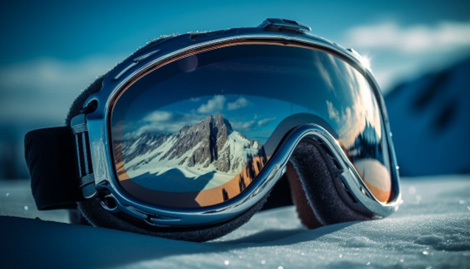
Things to consider when buying sunglasses for skiing:
Now that you have all the facts you need, if you have chosen to wear sunglasses in your next skiing experience, we have some tips for buying ( or choosing) the best sunglasses for skiing.
- UV Protection: Look for sunglasses that offer 100% UV protection to shield your eyes from harmful UV rays, especially in high-altitude mountain environments.
- Lens Quality: Choose lenses made of high-quality materials like polycarbonate or Trivex that are impact-resistant and durable. Polarized or mirrored lenses can help reduce glare from snow and ice.
- Lens Color and VLT: Select lenses appropriate for the skiing conditions. Darker lenses are suitable for bright, sunny days, while lighter lenses (with lower Visible Light Transmission, or VLT) work better for overcast or low-light conditions.
- Fit: Ensure a secure, comfortable fit that doesn’t obstruct peripheral vision. Please look for sunglasses compatible with your helmet for a seamless and comfortable combination.
- Coverage: Opt for sunglasses with a wraparound style to provide maximum coverage and protection from wind, snow, and peripheral sunlight.
- Anti-Fog Coating: Consider sunglasses with anti-fog coatings or ventilation to prevent fogging during active skiing.
- Durability: Choose sunglasses with sturdy frames and scratch-resistant lenses to withstand the rigors of skiing.
- Cost and Brand: Research reputable brands known for their quality and durability. Consider the cost of the features and protection offered by the
Considering these factors, you can ensure your sunglasses don’t fall short compared to goggles.
Some of the most frequently asked questions about skiing eyewear(FAQ)
If you have come this far, you are worthy of the prize of getting answers to your most frequent questions, and we are here to answer every single one that comes to mind.
Can I ski with regular sunglasses, or Do you know if I need specific ski sunglasses?
Of course you can! While you can technically ski with regular sunglasses, it’s generally recommended to use specific ski sunglasses for the best experience. Ski sunglasses are designed with impact resistance, UV protection, anti-fog capabilities, and optimal lens tints for varying light conditions, providing better slope performance and protection. They also offer a more secure fit with helmets and provide better coverage. So, while you can hit the slopes with regular sunglasses, investing in a pair of ski-specific sunglasses can significantly enhance your skiing experience and ensure your eyes are well-protected.
What should I consider when choosing ski sunglasses?
As we said above, When choosing skiing sunglasses, there are a few key things to consider. First, please look for sunglasses with 100% UV protection to protect your eyes from the sun’s harmful rays, especially at higher altitudes. Opt for durable, impact-resistant lenses and a comfortable, secure fit that won’t obstruct your vision. Consider lens color and Visible Light Transmission (VLT) to match different lighting and weather conditions on the slopes. Also, features like anti-fog coatings and compatibility with your ski helmet can make a big difference. Considering these factors, you can find the perfect pair of sunglasses to keep you stylish and protected while you enjoy your ski trip!
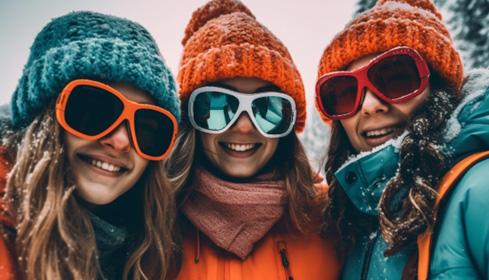
Are there any special lens features I should look for in ski sunglasses?
Absolutely! When choosing ski sunglasses, it’s essential to consider special lens features that can enhance your skiing experience. Look for sunglasses with polarized lenses to reduce glare and improve visibility, especially in snowy or sunny conditions. Additionally, consider lenses with anti-fog coatings to maintain clear vision while skiing. Photochromic lenses that adapt to changing light conditions can also be an excellent feature for versatility on the mountain. UV protection is crucial, so please ensure the sunglasses offer 100% protection. These features can make a real difference in your comfort and performance while skiing, so watch for sunglasses that provide these special lens features.
Can I wear ski sunglasses with a helmet?
Absolutely! You can wear sunglasses with a helmet while skiing. Many skiers prefer this combination for its style and practicality. When wearing sunglasses with a helmet, consider the fit and compatibility to ensure they sit comfortably and securely on your face. Look for sunglasses with a flexible frame that can accommodate the helmet, and check that there are no discomfort or pressure points when wearing both together. Safety and style come together when you find the right sunglasses-helmet combo.
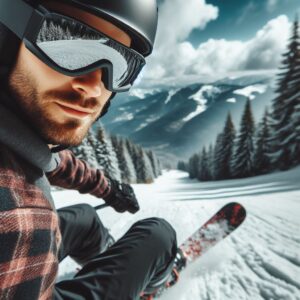
How do I prevent my ski sunglasses from fogging up while skiing?
Keeping your ski sunglasses from fogging up while skiing can significantly improve your visibility and overall slope experience. One effective way to prevent fogging is to choose sunglasses with anti-fog coatings or ventilation systems that allow air circulation. Additionally, you can use anti-fog sprays or wipes designed explicitly for eyewear to keep your lenses clear. Another handy tip is to ensure a proper fit that allows some airflow between your face and the sunglasses, which can help prevent fogging. Also, if you wear a face covering or while skiing, make sure it’s breathable to minimize condensation. These preventative measures let you keep your sunglasses fog-free and enjoy clear vision as you carve through the snow!
What are the considerations for wearing sunglasses in different skiing conditions (sunny, overcast, snowy)?
Wearing the right sunglasses for different skiing conditions is super important. Here’s the lowdown:
For sunny days, Look for sunglasses with a darker tint or a mirror coating to block out those intense rays. Polarized lenses can also help reduce glare from the snow, making your vision more precise.
For overcast conditions, Choose sunglasses with a lighter tint or photochromic lenses that adjust to the changing light. This way, you’ll have clear vision no matter the weather swings.
For snowy days, Opt for sunglasses with a pink or rose-colored lens. These lenses enhance contrast, making seeing the variation in snow conditions easier while providing good protection from bright light.
Can I wear prescription sunglasses for skiing, or do I need unique prescription ski sunglasses?
Great question. If you already have prescription sunglasses, you can wear them for skiing. However, some people prefer unique prescription ski sunglasses for a few reasons.
Unique prescription ski sunglasses often come with features tailored to skiing, such as enhanced coverage to block out bright light and wind and designs that comfortably fit under a ski helmet. They’re also often equipped with impact-resistant lenses for added safety.
If your current prescription sunglasses work well for skiing and provide the necessary protection, they may be all you need. However, if you’re looking for the specific benefits of ski-specific prescription sunglasses, they could be a terrific option.
Whatever you choose, the most important thing is to ensure that your eyes have the proper protection and that you feel comfortable as you enjoy your experience. We hope the information we gave you was helpful and you are ready to decide.
